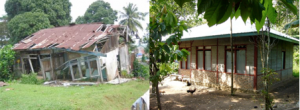Housing Series: Building a Strong Foundation, When Earthquakes Hurricanes Hit Affordable Housing
Editor’s Note: NextBillion has launched month-long series on Housing for All in partnership with Ashoka. This special series coincides with two upcoming Ashoka publications on best strategies to achieve Housing for All, Ashoka’s initiatives using its Hybrid Value Chain framework to leverage changes in the affordable housing sector in Brazil, Colombia and India. Please follow the series HERE and Join the discussion with your thoughts and insights.
“Earthquakes don’t kill people, poorly built buildings do,” says Elizabeth Hausler, a highly skilled engineer who turned her education into a life-long mission to conquer a dangerous social problem that kills and maims innocents and causes billions in damages in places all over the world.
“I grew up in a small town outside Chicago, where I’d work as a bricklayer during the summers for my father’s masonry construction company. After my college degree (in general engineering), I was working in environmental engineering while I was finishing my PhD in earthquake engineering, when three very important things happened all in the same year. First, an earthquake in Gujarat, India, killed over 20,000 people, mostly because their unreinforced masonry houses collapsed on them. That made me wonder why earthquakes were so deadly in emerging economies.
“Second, when the twin towers fell on September 11, I took it as a personal mission to use my engineering skills to make the world a better place. And third, I met the co-founder and CEO of KickStart, which had the right model for how to use technology to improve people’s lives. With these clearly imprinted in my mind and on my soul, I finished my dissertation, and with a Fulbright Fellowship, headed to India to be part of the reconstruction efforts following the earthquake.”
Thus began years of working around the world where earthquakes struck, and learning all she could about the specific challenges that make earthquakes so much more deadly for the poor.
Why Earthquakes and Hurricanes Disproportionately Hurt the BoP
“The problem, I discovered, is that most affordable housing building practices – or even earthquake-proof technologies – don’t fit the cultural preferences, economies or materials in the communities that need them,” she says, reflecting on many places she’s visited. “Most of the populations who suffer today in earthquakes never lived in brick houses with heavy roofs. They adapted to nature, to the traditional building designs of their ancestors, who had empirically adapted housing construction to either withstand – or at least not collapse with deadly force upon – people inside during an earthquake or a hurricane.”
But when they move to cities (either because their lands are depleted or no longer have enough water to farm, or their communities become caught in the midst of civil war or other conflicts, or simply because they need a closer, better school for their children – the houses they live in slums or outskirts of cities are built the “modern” way – i.e., made with bricks, concrete, and other materials not of their experience. And those houses most often are not built with the right standards or enough structural support to protect residents. High density of slums increase the risk factors once structural integrity fails.
 But it does not need to continue this way. “This is something that we can change if we know how to do it correctly,” says Hausler (pictured left), citing how developing the strategies and best practices to build safe and affordable housing became her life’s work and sparked her to found Build Change, an international non-profit social enterprise that designs earthquake-resistant houses in developing countries and trains builders, homeowners, engineers, and government officials to build them. It uses the principles of local skills, local materials and local demand – and leaves in place a suite of simple engineering principles which make permanent change in construction that can survive the violence of earthquakes and hurricane-force winds.
But it does not need to continue this way. “This is something that we can change if we know how to do it correctly,” says Hausler (pictured left), citing how developing the strategies and best practices to build safe and affordable housing became her life’s work and sparked her to found Build Change, an international non-profit social enterprise that designs earthquake-resistant houses in developing countries and trains builders, homeowners, engineers, and government officials to build them. It uses the principles of local skills, local materials and local demand – and leaves in place a suite of simple engineering principles which make permanent change in construction that can survive the violence of earthquakes and hurricane-force winds.
Build Change
Hausler’s approach is a sharp contrast with many “modern” programs that rebuild communities with disaster-proof homes, such as sturdy geodesic domes, that don’t fit in with the aesthetic or culture of the local community. As a result, the building technology isn’t replicated after the international helpers leave.
Hausler has formulated her work around ordered sets of principles. The first overarching set involves the three essential ingredients that build an ecosystem change in affordable housing construction that continues to guide it after the crisis is over. She calls these three principles: Technology, Money and People.
“Technology includes two things,” she says. “Clear government standards enforced to define construction project for common structures, and training and skilled technical assistance to get all builders the knowledge and expert advice they need.”
Money is critical – not only in access to it, but in how it is used. Hausler says that access to sufficient capital to build a house completely and correctly is a must to ensure safety. Hausler says governments and donors can help push quality standards by deferentially funding projects (or giving incentives to banks or microfinance institutions to approve loans for reconstruction) when proof of good plans meeting best practices for earthquake or hurricane resistant construction are submitted. In some places, where the right materials may be too expensive, governments could give subsidies to offset the costs – for example, when cement is an important component.
“People,” Hausler says, “are the key to making these changes widely adopted, commonplace and continue over time. It is critical to motivate residents, builders, government officials and relief agencies to want to rebuilt correctly.”
Hausler’s 3 C’s

(Before and after: A home damaged by an earthquake and rebuilt using Build Change techniques).
Many homes in disaster-prone areas do not know about Hausler’s three guiding principles of good construction: configuration, connections, and construction quality.
Configuration means paying attention to a home’s design plan and layout – keeping an eye out for things such as load-bearing walls in each direction of the home to improve durability. “In an earthquake, you don’t want a heavy roof over your head,” Hausler says, “while a lightweight roof in a hurricane-prone region needs to be tied down so it won’t blow away.”
Good configuration includes the placement of windows and doors. Such openings weaken the structural integrity of a wall that holds up the roof, but in many regions of the world lots of open windows and doors are needed for climate control. Instead of saying only small windows are acceptable, Hausler promotes putting reinforcements in place.
“The second C, connections, uses the engineering principle that everything has be connected together to perform well in an earthquake or hurricane,” Hausler continues. “Walls connected to the foundation, roof connected to the walls, etc.”
The third C, construction quality, is using locally available building materials and qualified labor. “This is another example of how doing it right can be simple, but must be learned, she says. “Laying bricks so that there’s enough mortar in the spaces in between. Or soaking bricks in water before building a wall to improve its strength. If you self-build or follow instructions from someone who has no experience with earthquakes or high winds – you may never learn to do construction this way – and it does not cost more or require anything special to get it safely done.”
By working in disaster-prone regions that currently lack the engineering expertise to build sturdy homes with limited funding, Build Change hopes to empower local homeowners and builders to continue implementing the three Cs long after the organization leaves town.
“That is the true test of sustainability,” Hausler says. “That is our ultimate goal: that people continue to build earthquake resistant houses on their own without us and without any financial subsidy.”
Hausler’s Strategic Steps

1. LEARN FIRST: Ask why did houses collapse in the earthquake? Why did others not collapse? Start out with forensic engineering studies after earthquakes, so we don’t make the same mistake twice.
 2. DESIGN EARTHQUAKE-RESISTANT HOUSES: Develop a process that includes those who need new houses – and those in the community who do not -alongside experts to ask: What types of houses do people want to build here, now? It’s easier to make minor, low or no-cost changes to existing ways of building than introduce a completely new technology, or reintroduce a traditional building method that has gone out of style.
2. DESIGN EARTHQUAKE-RESISTANT HOUSES: Develop a process that includes those who need new houses – and those in the community who do not -alongside experts to ask: What types of houses do people want to build here, now? It’s easier to make minor, low or no-cost changes to existing ways of building than introduce a completely new technology, or reintroduce a traditional building method that has gone out of style.
3. BUILD LOCAL SKILLS: Ask: How can we disseminate this knowledge to masses of engineers and builders?

4. STIMULATE LOCAL DEMAND: Ask: How can we convince a rural homeowner with little money to invest more to build a safer house?
5. FACILITATE ACCESS TO CAPITAL: Ask: What is the minimum amount of funding necessary to build a safe house?
6. MEASURE THE CHANGE. Ask: Are other people building safe houses now? Will they do so after the emergency or relief crews leave?

The best designs in the world will not save lives if they are not built properly, or local engineers remain unsure how to design them.
Make it affordable, easy to implement, and leverage the window of opportunity that exists right after an earthquake disaster. And…
And, how can we make it easy for local government officials to enforce building codes?
Create simple building codes, training seminars, and inspection systems that work in rural areas with little infrastructure, budget, time and personnel.
Build Change partners with governments and financing institutions to provide access to capital that is contingent upon meeting minimum standards for construction quality. And last but not least…
Seeing homeowners building safe houses with their own resources – not simply living in houses built for them – is the true test of sustainable, long-term change.
Please like NextBillion on Facebook, follow us on Twitter and/or join our LinkedIn group.
- Categories
- Social Enterprise
